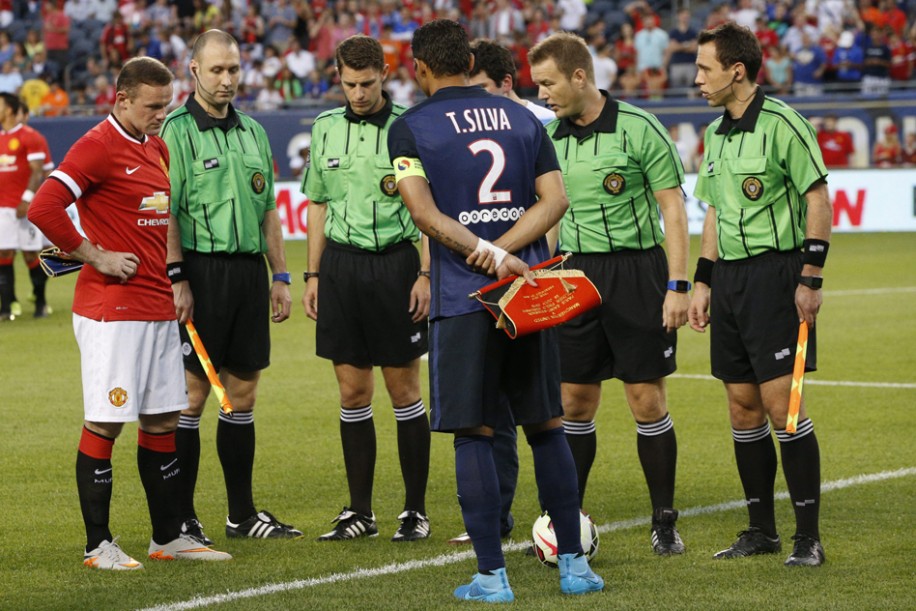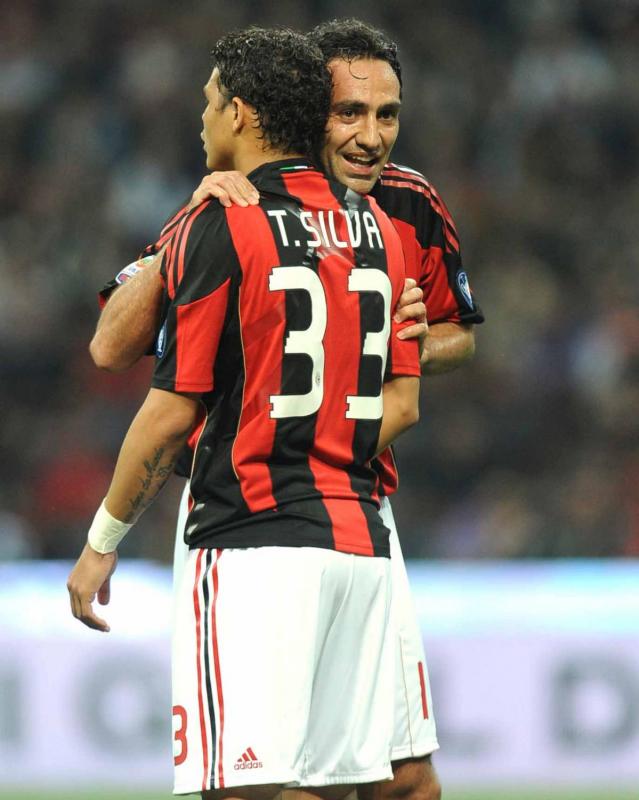From near retirement to captaining his country at their home world cup.
“Thiago Silva is my heir”. – Franco Baresi
Thiago Silva, O Monstro; one of the best, if not the best, centre back that this generation has produced, has had to endure more than the lion’s share of hardships to reach the top. His career was nearly over before it had even begun.
At the tender age of 14, Silva impressed the Fluminense coach, Maurinho, enough to be given a short trial as a defensive midfielder. He soon decided to try out for other clubs as his playing oppurtunities at Fluminense were limited, and at 15, Silva tried out for Flamengo, Madureira, Botafogo and Olaria and was rejected by them all. Eventually he was taken on by a small Brazilian club in the lower divisions, the namesake of one of the biggest clubs in world football: Barcelona. A year later Silva took part in a showcase tournament in São Paulo in order to thrust himself into the spotlight of a bigger club, Thiago impressed at this tournament and was picked up by RS Futebol Club. Even at this young age, Silva was catching admiring glances from Europe’s top clubs.
He continued to impress as a defensive midfielder for RS Futebol Club and one club that was particularly enthused by Thiago’s performances was Juventude, who swiftly completed a transfer for the then defensive midfielder. Thiago’s time at Juventude was short, 6 months in fact, but the influence it had on his career should not be underestimated. Under the Juventude coach, Ivo Wortmann; a former defensive midfielder himself, Silva transitioned from midfield to defence seamlessly and emphatically. Juventude made an astronomical leap during his 6 months at the club, from finishing 18th the previous year to finishing 7th. Silva was vital to this improvement and was rated by Placar, a Brazilian sports magazine, as the third best defender in Brazil and was chosen in their team of the season. At this point Thiago was viewed as one of the rising stars in Brazil and big clubs had started to take notice. He signed for Porto in 2004 for €2.5 million. Silva arrived in Portugal with his heart set on one goal; playing first team football for the Dragões, however his oppurtunities were limited and he only turned out for the reserve team; Porto B. The following year Thiago made the move east to Russia, signing for Dynamo Moscow.
This is where the trouble really began, the hardships he had encountered growing up; struggling to gather the money just to get the bus to training, the rejection he encountered in his youth and his failure at FC Porto all paled in comparison to what was to come next for the young centre back. He arrived in Moscow and was reunited with a familiar face in his former Juventude coach; Ivo Wortmann, the now Dynamo Moscow manager. The man who had previously engineered his move from midfield to defence. Everything seemed to be set for Silva to finally make his mark in European Football at a relatively big club, however this promise soon dissipated. Silva had been unwell for quite some time before Porto ran out of patience with him. While at Porto it seemed that he was unable to match the pace of his team mates, yet their medical staff couldn’t figure out what was making him complain of flu like symptoms. Silva’s poor health continued after he was shipped out to Dynamo and Russia’s oldest football club too, soon tired of his problems. He was released due to being unable to play matches. Silva’s health had deteriorated so much by this point that it had became clear that further tests were required. Thiago decided to remain in Russia whilst he underwent these tests; the young centre back was soon diagnosed with tuberculosis. While Porto’s medical team had missed what was holding Silva back and slowly killing him, the Russian doctors were able to identify it as tuberculosis has still not been eradicated within Russia meaning it was easier to spot for them.
Silva has spoken about his struggle with the disease to Gazzetta dello Sport magazine:
“The doctors would tell me to get up and go for a walk, but I couldn’t do it. This disease is contagious, so I was put in isolation. I found out that I’d had tuberculosis for six months. The doctors said if another two weeks had passed, I might not have been able to recover. I almost died. This is why, whenever I play, I think back to those moments in Russia. I had thought of quitting football altogether. There was an occasion when I went to Flamengo for a trial and after two sessions they said I could go as I was no better than any of the players they already had. I told my mother I didn’t want to play football anymore, as nobody wanted me. However, she said in that case I’d have to go work for my brother, so I immediately changed my mind and looked for another club”.
When Silva’s treatment ended after six months in hospital he was given two options: leave his lungs how they were and hope for a full recovery or cut out a piece. He chose the former, riskier option as the latter would have likely left him unable to continue his football career. Thiago has often joked about this, saying…
“It’s hard enough playing with two lungs, so imagine my trying to take on all these French and African attackers in Ligue 1 with only one-and-a-half lungs”.
Silva, in total, didn’t play football for an entire year and not for the first time; it looked like a career in football was going to slip through his fingers. Thiago returned to Brazil where he trialled for Flamengo but was unsuccessful, however his two time coach Ivo Wortmann was about to take over the reins at Fluminense. Wortmann was determined to sign Silva, despite his health issues, and on January 14th, 2006, Thiago Silva was announced as a Fluminense player, returning to the club he spent time at in his youth. Fluminense struggled throughout the 2006 season, resulting in a lowly 15th place finish. Silva, however, was regarded by Fluminense fans as a shining light in an otherwise poor season. O Monstro; the monster, was born. The following year was much more successful for both Silva and The Flu; securing a 4th place finish in the 2007 Brasileirão in a league campaign that saw them concede only 39 goals in 38 games, the second best in the league. Fluminense and Silva also won the 2007 Copa do Brasil for the first time. Silva started every game in the successful cup campaign, scoring in both the quarter final and the semi final. His brilliant form throughout the season led to his selection in Dunga, the then Brazil manager’s preliminary squad for the 2007 Copa América. After his impressive 2007 campaign, Silva was one of three nominees’ for ‘best central defender’. He was eventually selected as the second best central defender of the 2007 season in Brazil. Thiago’s last season in Brazil was a poor one for Flu, resulting in an uninspiring 14th placed finish; however it was Silva’s best to date on an individual level. He was awarded a shirt with the number 100 and a plaque to recognise his efforts and achievements after playing his 100th game for Fluminense. He was included in the 2008 Brasileirão Team of the Season and was called up to the 2008 Brazilian Olympics squad. In his last game at the Maracanã he was cheered by the supporters.
Silva made the leap to one of the Sette Sorelle; the Seven Sisters, of Italian football; AC Milan for around €10 million in 2009 but was unable to play competitive games at first; however he was still able to train. In his first few months he was taught new defensive techniques by Paolo Maldini and Carlo Ancelotti. Being unable to play competitive matches may have been seen as a hindrance at the time, but in hindsight it allowed Silva to focus on improving his game in ways he was not accustomed to. It also allowed Thiago to spend important time with Maldini, widely regarded as one of the best defenders of all time. This helped to improve his technique but also his not already unsubstantial football intelligence. Silva’s first game was a friendly vs. Hannover 96 in January of 2009; he performed well in his first run out in the Milan shirt and rightly drew praise from Seedorf, his then teammate. He was officially registered for the 2009/10 Serie A season.
Playing alongside Alessandro Nesta helped to improve Silva’s game further. His development at the Rossoneri was clear to see. Learning from two of the best defenders not only of their generation, but of all time in Maldini and Nesta, helped Thiago improve his technique, his heading ability and his sense of anticipation, amongst other areas. He played his first competitive game for Milan against Siena in August 2009. His performance gathered much praise with Maldini claiming that Silva ‘had the physical and technical characteristics of a champion’. Nesta, too, was impressed; claiming that Silva would ‘extend his life as a central defender’. High praise indeed. Silva took to European football with ease in his first season. Thiago’s second season in Italy led to him being regarded as the best defender in Serie A. His versatility was also shown, with an injury to Gattusso, Silva was chosen to play as Milan’s defensive midfielder, likely because of his previous time in that position but also because of his ability on the ball. In his first game for Milan in this position he completed more passes than anyone else, recovered the ball more than anyone else and even managed 3 shots at goal. Praise was heaped on Silva after this performance and there were many comparisons to the great Marcel Desailly, after the game he showed his determination to help the team by any means possible, saying that He’d “play as goalkeeper if it helped the team”. Silva helped guide Milan to the Scudetto playing in this position, at the end of the season he was regarded as the best defender in Italy and one of the best players.
His third season in Milan was his best yet, one of his most impressive performances was in a Champions League game vs. Barcelona where he and Nesta were vital in securing a 2-2 draw against the heavy favourites. He was voted into the FIFA world XI and there was no shortage of praise for Thiago: Gattusso compared him to the Rossoneri’s greatest ever player; Franco Baresi and Nemaja Vidic claimed that Silva was the best defender in the world. In this season, Silva became the first foreign captain of AC Milan in over 50 years, a remarkable achievement.
After a lengthy transfer saga, Thiago made the move to the French capital and signed for Paris Saint-Germain for €42 million. Here he was reunited with some familiar faces in Carlo Ancelotti and Zlatan Ibrahimovic, both admirers of his talent. Zlatan in particular has been quoted as saying ‘when I see Thiago Silva I see me, but as a defender. There is no defender in the world as complete as him’. Given the high regard in which Ibrahimovic holds himself, this is high praise indeed from the striker. Silva impressed in his first season and once again was inducted into the UEFA team of the year. He committed an astonishingly low 14 fouls throughout the 2012-13 league campaign. Silva and PSG were crowned champions of Ligue 1 in this season and the next with Thiago impressing both times. Silva has been criticised recently for a dip in form this season which may be due to a world cup ‘hangover’, after the Brazilians were embarrassed on their way out of the competition 7-1 by an emphatic German team. Although Silva played no part in this game he will have wished he could help his team and this is likely to have had an impact on his metal state. Another possible reason for his dip in form is being forced to play in the RCB position, Silva’s unfavoured side, due to David Luiz often not being trusted to cover the attacking fullback Aurier on the left. The difference between playing RCB and LCB is huge for centre backs and even the best struggle to maintain the same level of performance on their other side.
Thiago and David Luiz, despite Luiz’s obvious defensive lapses and unreliability, excel for the most part due to their close friendship and understanding of each other’s game that stems from their time playing together for the Seleção. Silva is often the player that goes to intercept the ball, as his reading of the game is far superior to that of Luiz’s. They make a solid centre back partnership due to their differences; Silva spreads calm throughout the team while Luiz energises it. Their close friendship also means that they are always aware of not wanting to let each other down; Luiz stated recently that ‘when Thiago bails me out after a mistake, I feel I have a duty to repay him’, meaning that they will go into every game at 100%. A great example of this partnership is in Brazil’s home World Cup campaign in their victory over Colombia, where Luiz and Silva were both potential man of the match candidates. Silva had a fantastic performance winning 71% of his aerial duels, completing 91% of his passes, making a couple of blocks, 4 interceptions, 14 clearances and scoring one goal.
Thiago Silva is widely regarded as the best centre back in the world by fans, pundits, players and coaches alike. Baresi, the great AC Milan defender one claimed that Thiago was his heir; if that isn’t a glowing recommendation then I don’t know what is. Silva is seen as the world’s most complete defender due to his calm composure on the ball, coupled with an extraordinary passing ability as well as his defensive capabilities. His ease on the ball and his passing strength likely stem from two things, one; being Brazilian can only help when it comes to on the ball ability as they are known more for their attacking ability and flair than anything else and secondly; Thiago was a defensive midfielder throughout his youth career. This has helped him become a centre back that is comfortable on the ball, showing the importance of young players learning more than one position. Silva has a great first touch and his composure and speed paired with a game intelligence that is seldom seen in this generation of centre backs, mean that he is always looking to drive into space with the ball when the opportunity presents itself, rather than being hesitant and slowing down and potential counter attacks. He is strong in the air, good at blocking the ball and his reading of the game is second to none. His football intelligence is best exemplified by a game he played for PSG vs. Olympiakos; Silva informed Blanc that he felt the defence was too exposed and a change needed to be made, the respect that Blanc has for Silva and the belief in his ability to read the game was evident here and he responded by replacing Ibrahimovic with Marquinhos. Thiago beats opponents in his head, his ability to read the game quicker than his opponents cannot be underestimated, and this speed of thought with the technical abilities to match is what makes him special.
Of course though, O Monstro has his weaknesses. He is often inconsistent and is prone to lapses in concentration. Also, for such a quick centre back he has sometimes been seen to struggle when he comes up against real pace. He has, in the past been criticised for being weak mentally, once refusing to take a penalty for Brazil and being pictured in tears away from the rest of the group, not what you want from your captain.
The imperious Brazilian centre back is the best of his generation, but is his rise to prominence due to his ability or a lack of competition for his crown? Would he have been held in such high regard if Baresi, Cannavaro, Nesta or Stam were still plying their trade at their peak? It seems unlikely. He is undoubtedly an incredibly talented defender but he’s not quite at that level and likely never will be as the Brazilian is now 30 years old and the sands of time stop for no man, not even one who has came through the life threatening and almost career ending battle with tuberculosis and forged himself into the best centre back of his time even after being forced to take a year out of football.
Jack
Latest posts by Jack (see all)
- The Rejuvenation of Thiago Silva - August 3, 2015
- Raheem Sterling: Stick or Twist? - July 9, 2015
- How to replace Lucas Leiva - February 9, 2015


